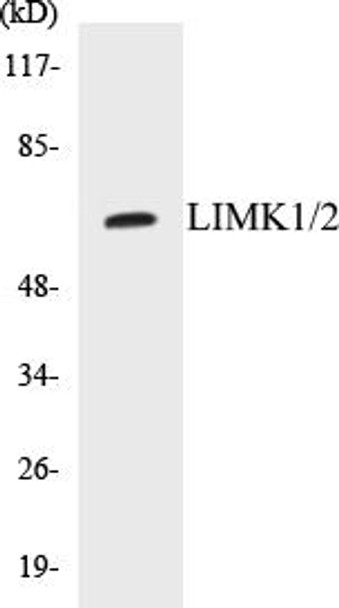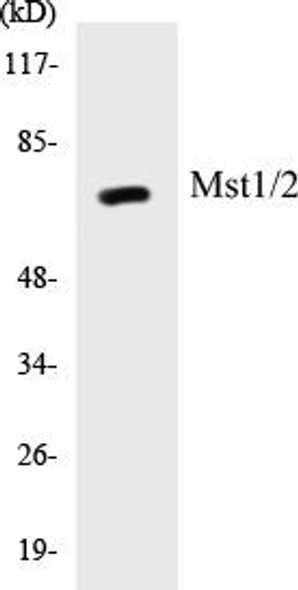LIMK1/2 Colorimetric Cell-Based ELISA Kit (CBCAB00737)
- SKU:
- CBCAB00737
- Product Type:
- ELISA Kit
- ELISA Type:
- Cell Based
- Reactivity:
- Human
- Mouse
- Rat
- Detection Method:
- Colorimetric
Description
LIMK1/2 Colorimetric Cell-Based ELISA Kit
The LIMK1 2-Colorimetric Cell-Based ELISA Kit is specifically designed for the accurate quantification of LIM domain kinase 1 (LIMK1) levels in various cell types and tissues. This innovative kit offers high sensitivity and specificity, ensuring precise and reliable results for your research needs.LIMK1 is a key regulator of actin cytoskeleton dynamics and cellular morphology, playing a critical role in cell migration, invasion, and metastasis. Dysregulation of LIMK1 has been implicated in various diseases, including cancer, neurodegenerative disorders, and autoimmune conditions, making it a valuable target for therapeutic interventions.
With the LIMK1 2-Colorimetric Cell-Based ELISA Kit, researchers can accurately measure LIMK1 levels in cell lysates, culture supernatants, and tissue homogenates, providing valuable insights into the role of LIMK1 in physiological and pathological processes. Trust in this cutting-edge kit for robust and reproducible results in your research endeavors.
| Product Name: | LIMK1/2 Colorimetric Cell-Based ELISA Kit |
| Product Code: | CBCAB00737 |
| ELISA Type: | Cell-Based |
| Target: | LIMK1/2 |
| Reactivity: | Human, Mouse, Rat |
| Dynamic Range: | > 5000 Cells |
| Detection Method: | Colorimetric 450 nmStorage/Stability:4°C/6 Months |
| Format: | 96-Well Microplate |
The LIMK1/2 Colorimetric Cell-Based ELISA Kit is a convenient, lysate-free, high throughput and sensitive assay kit that can detect LIMK1/2 protein expression profile in cells. The kit can be used for measuring the relative amounts of LIMK1/2 in cultured cells as well as screening for the effects that various treatments, inhibitors (ie siRNA or chemicals), or activators have on LIMK1/2.
Qualitative determination of LIMK1/2 concentration is achieved by an indirect ELISA format. In essence, LIMK1/2 is captured by LIMK1/2-specific primary antibodies while the HRP-conjugated secondary antibodies bind the Fc region of the primary antibody. Through this binding, the HRP enzyme conjugated to the secondary antibody can catalyze a colorimetric reaction upon substrate addition. Due to the qualitative nature of the Cell-Based ELISA, multiple normalization methods are needed:
| 1. | A monoclonal antibody specific for human GAPDH is included to serve as an internal positive control in normalizing the target absorbance values. |
| 2. | Following the colorimetric measurement of HRP activity via substrate addition, the Crystal Violet whole-cell staining method may be used to determine cell density. After staining, the results can be analysed by normalizing the absorbance values to cell amounts, by which the plating difference can be adjusted. |
| Database Information: | Gene ID: 3984, UniProt ID: P53667, OMIM: 601329, Unigene: Hs.647035 |
| Gene Symbol: | LIMK1 |
| Sub Type: | None |
| UniProt Protein Function: | LIMK1: a TKL kinase of the LISK family which mediates Rho signaling to cytoskeleton. Contains two N-terminal LIM motifs. Phosphorylated and activated by PAK1 and ROCK, downstream effectors of Rho. May be involved in brain development. Phosphorylates and inactivates the actin binding/depolymerizing factor cofilin and induces actin cytoskeletal changes. The LIM domain interacts with the cytoplasmic domain of NRG1. Binds ROCK1. Interacts with slingshot 1. Overexpressed in prostate tumors and prostate and breast cancer cell lines; manipulation of activity correlates with invasiveness in breast and prostate cancer models. Located within the 7q11.2 amplicon associated with metastatic prostate cancer. Loss of one copy of LIMK1 is the likely cause of visuospatial cognition defects seen in small chromosomal deletions associated with dominant Williams-Beuren syndrome Three splice variant have been identified. |
| UniProt Protein Details: | Protein type:Protein kinase, Ser/Thr (non-receptor); Kinase, protein; EC 2.7.11.1; Protein kinase, TKL; TKL group; LISK family; LIMK subfamily Chromosomal Location of Human Ortholog: 7q11.23 Cellular Component: cytoplasm; cytosol; neuron projection; nucleoplasm Molecular Function:heat shock protein binding; protein binding; protein serine/threonine kinase activity Biological Process: actin cytoskeleton organization and biogenesis; negative regulation of ubiquitin-protein ligase activity; nervous system development; positive regulation of actin filament bundle formation; positive regulation of axon extension; protein amino acid phosphorylation; Rho protein signal transduction; signal transduction Disease: Williams-beuren Syndrome |
| NCBI Summary: | There are approximately 40 known eukaryotic LIM proteins, so named for the LIM domains they contain. LIM domains are highly conserved cysteine-rich structures containing 2 zinc fingers. Although zinc fingers usually function by binding to DNA or RNA, the LIM motif probably mediates protein-protein interactions. LIM kinase-1 and LIM kinase-2 belong to a small subfamily with a unique combination of 2 N-terminal LIM motifs and a C-terminal protein kinase domain. LIMK1 is a serine/threonine kinase that regulates actin polymerization via phosphorylation and inactivation of the actin binding factor cofilin. This protein is ubiquitously expressed during development and plays a role in many cellular processes associated with cytoskeletal structure. This protein also stimulates axon growth and may play a role in brain development. LIMK1 hemizygosity is implicated in the impaired visuospatial constructive cognition of Williams syndrome. Alternative splicing results in multiple transcript variants encoding distinct isoforms.[provided by RefSeq, Feb 2011] |
| UniProt Code: | P53667 |
| NCBI GenInfo Identifier: | 90185240 |
| NCBI Gene ID: | 3984 |
| NCBI Accession: | P53667.3 |
| UniProt Secondary Accession: | P53667,O15283, Q15820, Q15821, Q75MU3, Q9Y5Q1, B7Z6I8 D3DXF4, D3DXF5, |
| UniProt Related Accession: | P53667 |
| Molecular Weight: | 68,729 Da |
| NCBI Full Name: | LIM domain kinase 1 |
| NCBI Synonym Full Names: | LIM domain kinase 1 |
| NCBI Official Symbol: | LIMK1 |
| NCBI Official Synonym Symbols: | LIMK; LIMK-1 |
| NCBI Protein Information: | LIM domain kinase 1 |
| UniProt Protein Name: | LIM domain kinase 1 |
| Protein Family: | LIM domain kinase |
| UniProt Gene Name: | LIMK1 |
| UniProt Entry Name: | LIMK1_HUMAN |
| Component | Quantity |
| 96-Well Cell Culture Clear-Bottom Microplate | 2 plates |
| 10X TBS | 24 mL |
| Quenching Buffer | 24 mL |
| Blocking Buffer | 50 mL |
| 15X Wash Buffer | 50 mL |
| Primary Antibody Diluent | 12 mL |
| 100x Anti-Phospho Target Antibody | 60 µL |
| 100x Anti-Target Antibody | 60 µL |
| Anti-GAPDH Antibody | 60 µL |
| HRP-Conjugated Anti-Rabbit IgG Antibody | 12 mL |
| HRP-Conjugated Anti-Mouse IgG Antibody | 12 mL |
| SDS Solution | 12 mL |
| Stop Solution | 24 mL |
| Ready-to-Use Substrate | 12 mL |
| Crystal Violet Solution | 12 mL |
| Adhesive Plate Seals | 2 seals |
The following materials and/or equipment are NOT provided in this kit but are necessary to successfully conduct the experiment:
- Microplate reader able to measure absorbance at 450 nm and/or 595 nm for Crystal Violet Cell Staining (Optional)
- Micropipettes with capability of measuring volumes ranging from 1 µL to 1 ml
- 37% formaldehyde (Sigma Cat# F-8775) or formaldehyde from other sources
- Squirt bottle, manifold dispenser, multichannel pipette reservoir or automated microplate washer
- Graph paper or computer software capable of generating or displaying logarithmic functions
- Absorbent papers or vacuum aspirator
- Test tubes or microfuge tubes capable of storing ≥1 ml
- Poly-L-Lysine (Sigma Cat# P4832 for suspension cells)
- Orbital shaker (optional)
- Deionized or sterile water
*Note: Protocols are specific to each batch/lot. For the correct instructions please follow the protocol included in your kit.
| Step | Procedure |
| 1. | Seed 200 µL of 20,000 adherent cells in culture medium in each well of a 96-well plate. The plates included in the kit are sterile and treated for cell culture. For suspension cells and loosely attached cells, coat the plates with 100 µL of 10 µg/ml Poly-L-Lysine (not included) to each well of a 96-well plate for 30 minutes at 37°C prior to adding cells. |
| 2. | Incubate the cells for overnight at 37°C, 5% CO2. |
| 3. | Treat the cells as desired. |
| 4. | Remove the cell culture medium and rinse with 200 µL of 1x TBS, twice. |
| 5. | Fix the cells by incubating with 100 µL of Fixing Solution for 20 minutes at room temperature. The 4% formaldehyde is used for adherent cells and 8% formaldehyde is used for suspension cells and loosely attached cells. |
| 6. | Remove the Fixing Solution and wash the plate 3 times with 200 µL 1x Wash Buffer for five minutes each time with gentle shaking on the orbital shaker. The plate can be stored at 4°C for a week. |
| 7. | Add 100 µL of Quenching Buffer and incubate for 20 minutes at room temperature. |
| 8. | Wash the plate 3 times with 1x Wash Buffer for 5 minutes each time. |
| 9. | Add 200 µL of Blocking Buffer and incubate for 1 hour at room temperature. |
| 10. | Wash 3 times with 200 µL of 1x Wash Buffer for 5 minutes each time. |
| 11. | Add 50 µL of 1x primary antibodies (Anti-LIMK1/2 Antibody and/or Anti-GAPDH Antibody) to the corresponding wells, cover with Parafilm and incubate for 16 hours (overnight) at 4°C. If the target expression is known to be high, incubate for 2 hours at room temperature. |
| 12. | Wash 3 times with 200 µL of 1x Wash Buffer for 5 minutes each time. |
| 13. | Add 50 µL of 1x secondary antibodies (HRP-Conjugated AntiRabbit IgG Antibody or HRP-Conjugated Anti-Mouse IgG Antibody) to corresponding wells and incubate for 1.5 hours at room temperature. |
| 14. | Wash 3 times with 200 µL of 1x Wash Buffer for 5 minutes each time. |
| 15. | Add 50 µL of Ready-to-Use Substrate to each well and incubate for 30 minutes at room temperature in the dark. |
| 16. | Add 50 µL of Stop Solution to each well and read OD at 450 nm immediately using the microplate reader. |
(Additional Crystal Violet staining may be performed if desired – details of this may be found in the kit technical manual.)






